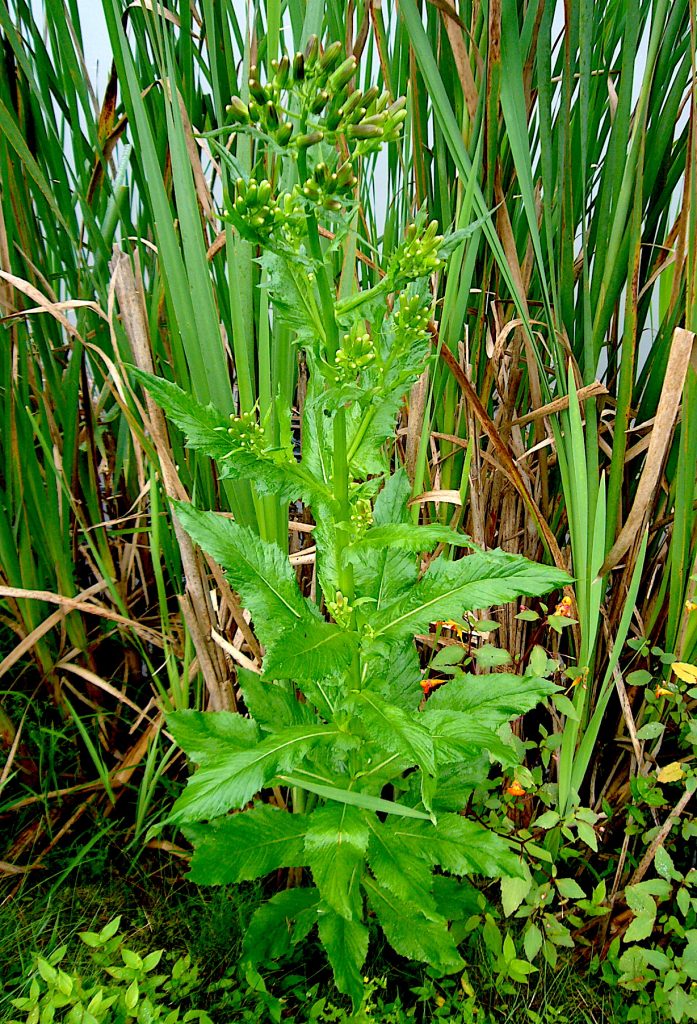
Burnweed/Fireweed in blossom in front of cattails. Photo by Green Deane
Fireweed/Burnweed has a flavor chefs love. As professionals they think differently about flavors, textures and possible applications. With an impossible scientific name and strong aroma Fireweed is often over looked by the foraging community. Conversely the aroma is also a good identifying characteristic. As with several things in life tastes vary and many people enjoy the Fireweed raw or cooked. Forager emeritus Dick Deuerling used to say about wild plants that he only ate the good stuff and fireweed was not the good stuff. Closely related to the Dandelion, the Fireweed locally favors the late winter or early spring. Currently you can find Fireweed from a few inches high to a couple of feet. While they do not grow in colonies often several will grow near each other. Soon the older ones will put on green-yellow blossoms that barely open, another identifying characteristic. Of course in greens young and tender is usually preferable and this is particularly true with the Fireweed which grows rank as it ages. To read about fireweed go here.
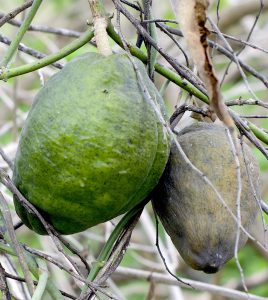
Fruit of the Latex Strangler Vine. Photo by Green Deane
Another recent find was Latex Strangler Vine. At one time a bane of the citrus industry the lengthy vine grows edible fruit that is high in vitamin C. It’s called “Strangler” because it can cover a citrus tree shading it out and killing it. The specie was “found” twice in Florida some twenty-five years apart in the last century. The state unsuccessfully spent millions trying to get rid of it Look for it on fences and around current or old citrus groves. Decades ago when the weather was warmer the vine was common wherever there was citrus. Cooler weather has frozen it and citrus out on the north end of the state. I have seen Latex Strangler Vine in Ocala and near Gainesville but that’s the limit. In both cases the plants were under Live Oaks and in unmowed areas. It is quite common mid-state and south. The blossoms are edible off the vine. The raw leaves can also be eaten but are usually dipped in oil first. My article on the species is here. I also have a video on the species here.

Foraging classes are held rain or shine, heat or cold. Photo by Nermina Krenata
Foraging Classes: The weather might be iffy this coming weekend for classes spanning both coasts. Classes are held in the rain, except for hurricanes.
Saturday, March 23rd, Red Bug Slough 5200 S. Beneva Road, Sarasota. 9 a.m. to noon. Meet at the parking lot.
Sunday, March 24th, Spruce Creek Park, 6250 Ridgewood Ave. Port Orange, 32127, 9 a.m. to noon. Meet at the pavilion.
For more information on these classes, to prepay or sign up go here.
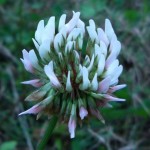
Clover prefers low nitrogen soil.
Clover is one of those wild edibles that is both overstated and understated. The overstatement is from writers who offer it as a great human food full of this and that to keep us healthy. The understated part is that it can harbor a fungus that inhibits clotting and somewhere around a half-a-cup of raw leaves can make you throw up. Individual experience, of course, can vary and there are several different species of clover with different characteristics. Pictured here is a nice little White Clover which is blossoming now mostly in lawns and athletic fields. A few leaves can be eaten raw. They are high in protein for a leaf. The blossom fresh or quickly dried can be used for tea. There is also Crimson, Red, Sweet and even Tick Clover.
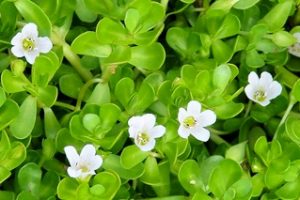
Bacopa monnieri can have four or five petals.
Before I forget it’s time to write about Bacopa again. Actually there are six Bacopas locally, two common: Water Hyssop and Lemon Bacopa. They are quite different and perhaps it takes a trained botanical eye to appreciate their similarities which strike me as few. Perhaps their greatest difference is texture. Lemon Bacopa is soft, fuzzy, and crushes easily. It smells like limes not lemons. Water Hyssop is tough and shiny, resilient. Lemon Bacopa is aromatic and fruity in flavor, Water Hyssop is just pain bitter. Water Hyssop definitely can help with memory issues, Lemon Bacopa is more iffy on that score. One does not find Lemon Bacopa too often whereas Water Hyssop is nearly everywhere the soil is wet and sunny. (There are actually five Bacopas that look like the bitter one we want but four of them are rare. The one we want, Bacopa monnieri, by far the most common, has a single crease/line on the leaf.) I have found Lemon Bacopa only three times; two of them in the wet ruts of woods roads. There is also a lake near me that has a little growing near a boat ramp when the water level is just right. As my article speaks more towards Lemon Bacopa I will address Water Hyssop here. It basically stimulates the brain to make new neuronal connections, specifically in the hippocampus. It is anti-inflammatory and interacts with the dopamine and serotenergic systems. As you might expect growing new memory cells enough to notice takes time. So Bacopa has to be taken daily for at least three months. I have had several people tell me it has made significant difference in their lives. It does not work on all causes of memory problems but if it does work it does so dramatically. You can read about both Bacopas here.

You get the USB, not the key.
172-video USB would be a good end of spring present and is now $99. My nine-DVD set of 135 videos has been phased out. The USB videos are the same videos I have on You Tube. Some people like to have their own copy. Most of the 172 USB videos have to be copied to your computer to play. If you want to order the USB go to the DVD/USB order button on the top right of this page. That will take you to an order form.

Green Deane Forum
Want to identify a plant? Perhaps you’re looking for a foraging reference? You might have a UFO, an Unidentified Flowering Object, you want identified. On the Green Deane Forum we — including Green Deane and others from around the world — chat about foraging all year. And it’s not just about warm-weather plants or just North American flora. Many nations share common weeds so there’s a lot to talk. There’s also more than weeds. The reference section has information for foraging around the world. There are also articles on food preservation, and forgotten skills from making bows to fermenting food. Unfortunately this portion of my website has been disfunctional recently, efforts have been made to fix it.
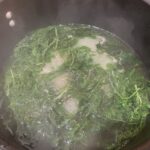
Stinging nettles boiling.
Noticed this week, was a proliferation of stinging nettles. Cooking nettles eliminates their sting plus they are high in calcium and potassium. I harvest them wearing gloves, stripping the leaves from the top of the stem to the bottom. I also rinse them as the stinging hairs can cling to sand. They take very little cooking. They are good with butter or balsamic vinegar.
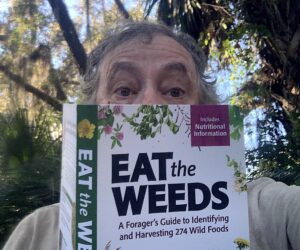
Finally, a physical copy of the book.
Now in its second printing is EatTheWeeds, the book. It has 275 plants, 367 pages, index, nutrition charts and color photos. It’s available in many locations including Amazon. Most of the entries include a nutritional profile. It can also be ordered through AdventureKeen Publishing.
This is weekly newsletter #593. If you want to subscribe to this free newsletter you can find the sign-up form in the menu at the top of the page.
To donate to the Green Deane Newsletter click here.

